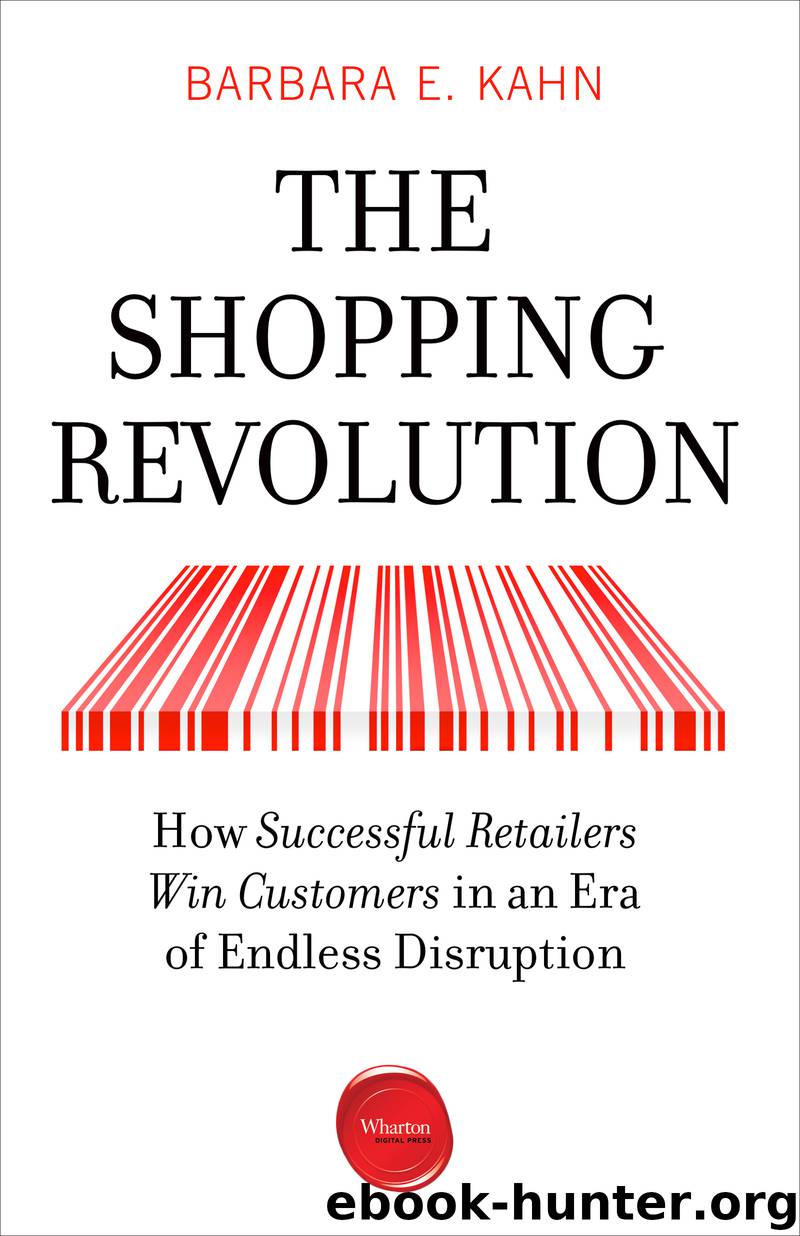The Shopping Revolution by Barbara E. Kahn

Author:Barbara E. Kahn
Language: eng
Format: epub
Publisher: Wharton Digital Press
Source: Pixlee, The Top 25 Digitally Native Vertical Brands Report, 2017.
How Did These Retailers Build Their Brand Narratives? Some Examples
The key to these V-brand retailers’ success is their brand story, and each is unique. I will summarize the marketing strategies of a few of the key retailers.
Zara
Zara, an international clothing retailer owned by Inditex and headquartered in Spain, was founded in 1975. From the start, its mission was to provide clothing that offers fashionable new designs (many times copies of popular, higher-priced fashion styles) that were made from quality materials—and were affordable. To deliver on this mission, the company invested in a manufacturing and distribution process that could reduce lead times and react to trends faster. It invested in IT extensively and expanded globally. There are now over 7,000 Zara stores, and the retailer is still growing rapidly.
Zara was one of the originators of “fast fashion.” Unlike the 12-to-18-month lead times of many of its fashion competitors, Zara could design and sell its collection in only four weeks. Most fashion brands are top-down, depending upon well-known, talented designers to dictate the styles and fashions for the season. Zara works from the bottom up. The retailer watches trends and consumers’ reactions to them, sees what people are wearing, monitors fashion blogs and fashion shows, and then produces designs that it believes will appeal to its customers.
This approach largely works well, although occasionally there are bumps in the road, primarily around accusations of putative plagiarism. The company has been sued in the past by indie designers and high-end brands, but most of the cases get resolved in Zara’s favor because the company is able to tweak the design enough to get around copyright laws. This approach may not serve designers well, but customers react very positively.
Being so customer-focused means that Zara is less likely to guess wrong on which styles will be hot, and therefore less likely to have excess inventory at the end of the season. Zara also increases the desirability of its designs by producing less of each style and changing what it has on its sales floors frequently. This means that it carries much less inventory of any particular style, again lowering the risk of failed forecasting.
This frequent turnover of inventory drives the customer into the store more often to see what is new. It also teaches the customer that if she sees something she likes, she should purchase it right away because it might not be there next time. Zara’s influence on the marketplace has been so great that traditional houses like Prada and Louis Vuitton have started to make four to six collections each year rather than just two.
With these strategies in place, each of the styles only stays in the store for three to four weeks, thus inventory turns 17 times per year. In order to encourage more purchasing, Zara’s founder, Amancio Ortega, has encouraged his customers to think of clothing as a perishable commodity, or “disposable clothing.” People should buy the latest trends, wear them, then throw them out, and buy the next trend.
Download
This site does not store any files on its server. We only index and link to content provided by other sites. Please contact the content providers to delete copyright contents if any and email us, we'll remove relevant links or contents immediately.
Follow Up and Close the Sale: Make Easy (and Effective) Follow-Up Your Winning Habit by Jeff Shore(772)
RFID For Dummies by Sweeney Patrick J(568)
eBay Business All-in-One For Dummies by Marsha Collier(555)
Follow Up and Close the Sale by Jeff Shore(531)
Remarkable Retail by Steve Dennis(512)
Online Reputation Management For Dummies by Lori Randall Stradtman(510)
Aubuchon Hardware by Bernard W. Aubuchon Jr(503)
eCommerce in the Cloud by Kelly Goetsch(481)
luxury online by Uché Okonkwo(477)
Statistical and Machine-Learning Data Mining by Ratner Bruce(466)
Instagram POWER: Build Your Brand and Reach More Customers with the Power of Pictures by JASON G. MILES(461)
The Nordstrom Way to Customer Service Excellence by Robert Spector & Patrick Mccarthy(460)
Start Your Own eBay Business by Christopher Matthew Spencer(451)
Location Based Marketing For Dummies by Aaron Strout(450)
Strategic Digital Marketing: Top Digital Experts Share the Formula for Tangible Returns on Your Marketing Investment by Kates Alexander & Greenberg Eric(407)
Selling Naked by Jesse Horwitz(376)
Street Democracy by Sandra C. Mendiola García(367)
Dynamic Digital Marketing by Dawn McGruer(363)
The Art of Retail Buying by Marie-Louise Jacobsen(363)
